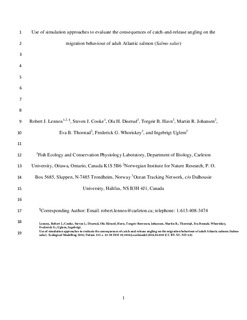Use of simulation approaches to evaluate the consequences of catch-and-release angling on the migration behaviour of adult Atlantic salmon (Salmo salar)
Lennox, Robert J.; Cooke, Steven J.; Diserud, Ola Håvard; Havn, Torgeir Børresen; Johansen, Martin R.; Thorstad, Eva Bonsak; Whoriskey, Frederick G.; Uglem, Ingebrigt
Journal article, Peer reviewed
Accepted version

Åpne
Permanent lenke
http://hdl.handle.net/11250/2480609Utgivelsesdato
2016Metadata
Vis full innførselSamlinger
- Publikasjoner fra CRIStin - NINA [2397]
- Scientific publications [1423]
Sammendrag
Given most Atlantic salmon (Salmo salar) released by anglers survive (proportion = 0.97 in this study), eco-nomically and culturally important recreational Atlantic salmon fisheries are increasingly incorporatingcatch-and-release. Sublethal alterations to behaviour with potential individual fitness costs are a possibleconsequence of catch-and-release but are difficult to measure empirically relative to uncaptured fish. Totest for sublethal effects of angling on migratory movements, 39 salmon were captured by recreationalanglers, externally tagged with radio transmitters, and released. Data from the annual visual drift countof spawning salmon were used to calculate the probability of spawning in each pool of the river and inputinto simulation models. Simulation models were used to test the hypothesis that catch-and-release didnot affect the upriver movement of 30 salmon tracked to spawning grounds. Ten thousand simulationsteps selected a spawning pool for each of the tagged salmon, permitting a calculation of the averageexpected movement by salmon for comparison to the average movement observed with telemetry. Theaverage observed movement by the released salmon was significantly less than the average expectedmovement generated by all three null models, indicating a sublethal effect of catch-and-release on themigration of Atlantic salmon.© 2016 Elsevier B.V. All rights reserved.
